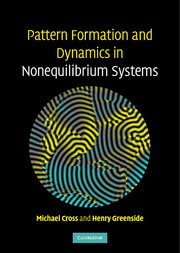Book contents
- Frontmatter
- Contents
- Preface
- 1 Introduction
- 2 Linear instability: basics
- 3 Linear instability: applications
- 4 Nonlinear states
- 5 Models
- 6 One-dimensional amplitude equation
- 7 Amplitude equations for two-dimensional patterns
- 8 Defects and fronts
- 9 Patterns far from threshold
- 10 Oscillatory patterns
- 11 Excitable media
- 12 Numerical methods
- Appendix 1 Elementary bifurcation theory
- Appendix 2 Multiple-scales perturbation theory
- Glossary
- References
- Index
Appendix 1 - Elementary bifurcation theory
Published online by Cambridge University Press: 05 August 2012
- Frontmatter
- Contents
- Preface
- 1 Introduction
- 2 Linear instability: basics
- 3 Linear instability: applications
- 4 Nonlinear states
- 5 Models
- 6 One-dimensional amplitude equation
- 7 Amplitude equations for two-dimensional patterns
- 8 Defects and fronts
- 9 Patterns far from threshold
- 10 Oscillatory patterns
- 11 Excitable media
- 12 Numerical methods
- Appendix 1 Elementary bifurcation theory
- Appendix 2 Multiple-scales perturbation theory
- Glossary
- References
- Index
Summary
This appendix provides some of the background for Chapter 4, especially for Eq. (4.14), by reviewing some of the elementary bifurcation theory that is often discussed in an introductory undergraduate course on nonlinear dynamics. Bifurcation theory is concerned with the change in the nature of solutions as parameters are varied. The changes can involve changes in the numbers or types of attractors, in the structure of the basins of attraction, or in even more subtle details of the phase space that are not easily detected by experiment. Sufficiently close to the onset of a bifurcation of a fixed point, a combination of a perturbation expansion and of nonlinear changes of variables can reduce the evolution equations to a much simpler dynamical system (usually a few odes) called a normal form. The normal form captures the essential behavior of the evolution equations sufficiently close to the bifurcation point and can be used to classify the possible bifurcations. For our purposes, the classification and associated language (e.g. pitchfork, Hopf, and other kinds) are the more important topics so we do not show how to reduce a set of equations describing a physical system to normal form, which can involve lengthy calculations, even with a computer mathematics program.
We begin our discussion by analyzing the bifurcations of some simple one variable dynamical systems and then discuss how these systems are related to the normal forms of more complicated evolution equations.
Information
- Type
- Chapter
- Information
- Pattern Formation and Dynamics in Nonequilibrium Systems , pp. 496 - 502Publisher: Cambridge University PressPrint publication year: 2009
